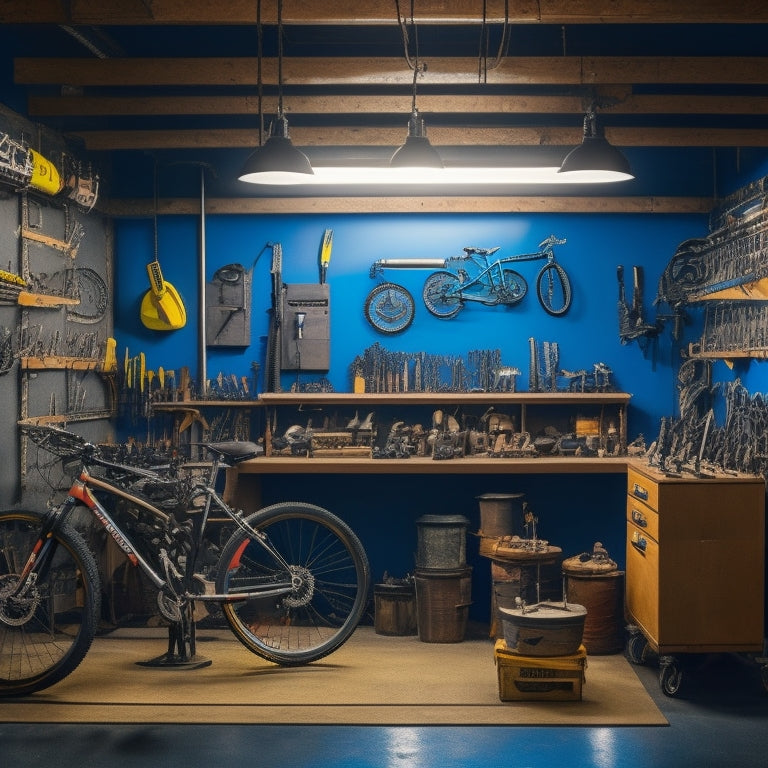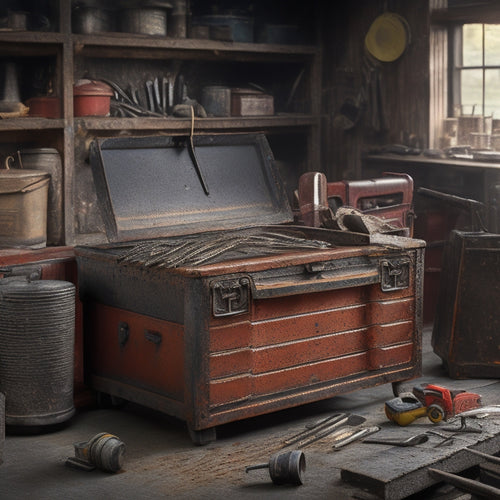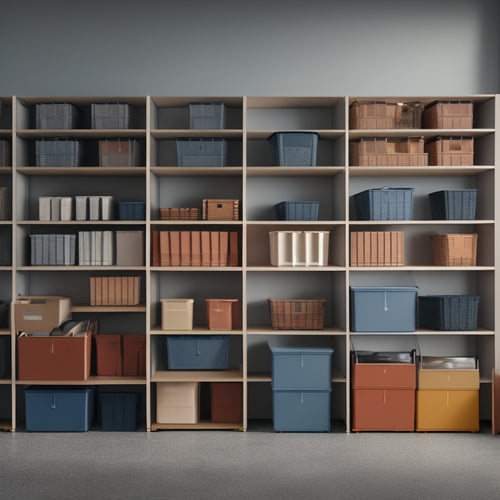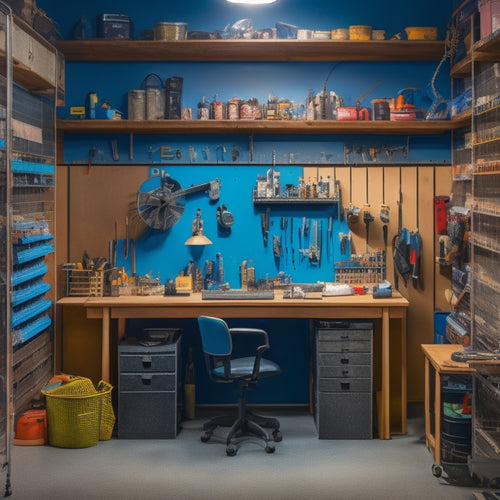
What Makes a Great Bike Maintenance Station?
Share
You'll need a well-planned bike maintenance station that combines essential tools, efficient organization, and customizable storage solutions to guarantee a smooth workflow, reduce errors, and maximize productivity. A great station should have a well-equipped toolbox with must-haves like multi-tools and cable cutters, a reliable pump or CO2 cartridge inflator, and a compact workstand for secure bike holding. Efficient organization and layout ideas, such as pegboards and tool holders, are also vital. By incorporating these elements, you'll set yourself up for success - and that's just the starting point for creating an exceptional bike maintenance station.
Key Takeaways
• A well-organized workspace with a secure workstand, ergonomic setup, and bright lighting enables efficient bike maintenance and reduces fatigue.
• A comprehensive toolkit with essentials like multi-tool, tire levers, and Allen wrenches ensures that all tasks can be performed with ease.
• Customizable storage solutions with labeled bins and hooks keep tools and parts within easy reach, saving time and increasing productivity.
• A well-planned layout with designated zones for work, tools, and supplies streamlines the maintenance process and minimizes clutter.
• Regular tool maintenance and a checklist for common mistakes to avoid ensure that bikes are serviced correctly and safely.
Essential Tools for Bike Repair
Having a well-equipped toolbox with the right essentials enables you to handle common bike repairs and adjustments efficiently. As a bike maintenance enthusiast, you know that having the appropriate tools at your disposal can make all the difference. That's why investing in a portable toolkit is a great idea. These space-saving solutions allow you to carry the essentials with you, making quick fixes and emergency repairs a breeze.
When building your toolkit, prioritize the must-haves. A good quality multi-tool, tire levers, and Allen wrenches are essential for most bike repairs. Don't forget a set of cable cutters, pliers, and screwdrivers. Having a reliable pump or CO2 cartridge inflator will also guarantee you're always prepared to handle a flat tire.
Consider a compact, portable workstand to hold your bike securely while you work. Finally, add some basic supplies like patch kits, lubricants, and cleaning solutions to round out your toolkit. With these essentials at your fingertips, you'll be prepared to tackle any bike repair that comes your way.
Pegboard Accessories and Add-Ons
As you set up your bike maintenance station, consider adding pegboard accessories and add-ons to maximize storage and efficiency, allowing you to quickly access the tools you need.
A well-organized pegboard is crucial for a smooth workflow, and with the right accessories, you can optimize your workspace.
Start by adding hooks for hanging tools like wrenches, screwdrivers, and pliers. This will keep them within easy reach and prevent clutter from building up on your workbench.
You can also add bins and containers for storing small parts, such as bolts, nuts, and screws. Label each bin to make certain you can quickly find what you need.
To further enhance pegboard organization, consider adding a tool holder with individual slots for each tool. This will keep your tools organized and prevent them from getting mixed up or lost.
Efficient Workstation Layout Ideas
With a well-organized pegboard in place, you can now focus on designing an efficient workstation layout that streamlines your bike maintenance process and reduces workflow bottlenecks. A well-designed layout is essential to achieving best functionality and reducing fatigue. To create an ergonomic setup, consider the following layout ideas:
| Zone | Functions | Benefits |
|---|---|---|
| Work Zone | Bike repair, maintenance | Efficient workflow, reduced fatigue |
| Tool Zone | Tool storage, organization | Quick access, reduced clutter |
| Supply Zone | Supply storage, inventory management | Easy restocking, optimized inventory |
Customizable Storage Solutions Needed
When setting up your bike maintenance station, you'll need to contemplate customizable storage solutions that cater to your specific needs.
You'll want to invest in a tool organization system that keeps your gear within easy reach, ensuring you can quickly access the right tool for the job.
Additionally, adjustable shelving options will allow you to maximize your storage space and accommodate components of various sizes.
Tool Organization Systems
You'll need a tailored tool organization system that adapts to your specific bike maintenance requirements, ensuring every wrench, screwdriver, and pedal wrench has a designated home. This is essential for maximizing efficiency and reducing frustration during repairs. A well-organized system allows you to quickly locate the tools you need, saving time and increasing productivity.
| Tool Category | Storage Solution |
|---|---|
| Hand tools (wrenches, pliers) | Pegboard with hooks and bins |
| Precision tools (screwdrivers, Allen wrenches) | Compact drawer organizer with dividers |
| Specialty tools (pedal wrench, chain breaker) | Magnetic strip with labeled slots |
| Cleaning supplies | Adjustable shelving with baskets |
| Lubricants and chemicals | Lockable cabinet with labeled shelves |
When designing your tool organization system, consider the frequency of use, tool size, and storage capacity. Customization is key to creating a system that works for you. By allocating a specific space for each tool, you'll maintain a clutter-free workspace, reduce tool loss, and enhance your overall bike maintenance experience.
Adjustable Shelving Options
Adjustable shelving options provide the flexibility to accommodate various sizes of cleaning supplies, such as degreasers, brushes, and rags, allowing you to configure the storage space to meet your specific bike maintenance needs.
This customizable storage solution guarantees that you can efficiently store and retrieve the supplies you need, making your maintenance process more efficient.
With adjustable shelves, you can modify the height and width of the shelves to fit different sizes of containers, tools, and accessories.
This feature is particularly useful when working with bikes of varying sizes or types, as you can adapt the shelving to accommodate the unique requirements of each bike.
Common Bike Maintenance Mistakes
Many cyclists overlook crucial steps, leading to avoidable issues, such as worn-out brake pads or rusty chains, which can compromise their safety and bike's performance. You can avoid these common mistakes by taking precautionary measures to guarantee your bike is in top condition.
One mistake is neglecting to clean your bike regularly, which can lead to dirt and grime accumulating and causing wear on moving parts. Another mistake isn't checking and adjusting your bike's tire pressure regularly, which can lead to reduced traction and increased risk of punctures.
Additionally, failing to lubricate your chain and other moving parts can cause excessive wear and tear. By taking the time to perform routine maintenance tasks, you can prevent these issues and ensure your bike runs smoothly and efficiently.
Space-Saving Design Strategies Used
When designing your bike maintenance station, you'll want to maximize every inch of space to guarantee a clutter-free and efficient workspace.
To achieve this, you'll need to employ space-saving design strategies that make the most of your available area.
Compact Shelving Solutions
You'll maximize floor space by incorporating vertically stacked shelving units with retractable baskets, allowing easy access to frequently used bike maintenance tools and supplies. This space optimization strategy enables you to store a wide range of items, from small parts to larger equipment, in a compact and organized manner.
By utilizing compact shelving solutions, you'll be able to allocate more room for workstations, benches, or other essential components of your bike maintenance station.
To further enhance storage solutions, consider implementing a labeling system to identify the contents of each basket or shelf. This will save you time and effort when searching for specific tools or supplies.
Additionally, consider the tool placement strategy you employ. Grouping similar items together, such as wrenches or lubricants, will streamline your workflow and reduce clutter.
Optimized Corner Utilization
By incorporating curved corner shelves or carousels that rotate to bring items to your fingertips, your bike maintenance station can reclaim dead space in corners, typically wasted areas that can now be leveraged to store infrequently used tools or supplies. This optimized corner utilization enhances corner efficiency, allowing you to make the most of your workspace.
To maximize functionality, consider installing corner-mounted bins or baskets to store small parts, accessories, or cleaning supplies. These space-saving solutions keep essential items within easy reach, streamlining your workflow and reducing clutter. By utilizing every available inch, you'll create a more efficient workspace that enables you to focus on providing excellent bike maintenance services.
When designing your bike maintenance station, prioritize workspace optimization by incorporating these corner-saving strategies. By doing so, you'll create a well-organized, functional space that allows you to work efficiently and effectively, ultimately providing better service to your customers.
Vertical Storage Options
In addition to reclaiming corner space, consider installing floor-to-ceiling shelving units or wall-mounted storage systems to maximize your bike maintenance station's vertical storage capacity.
This will allow you to store more items without sacrificing floor space, making it an ideal space-saving solution.
Look for innovative design features such as adjustable shelves, bins, and hooks to customize your storage system to your specific needs.
Key Features of a Great Station
Your ideal bike maintenance station should boast a robust workstand capable of securely holding your bike in place, allowing for effortless spinning of the wheels and pedals. This ensures you can focus on the task at hand without worrying about your bike tipping over.
A great station should also feature an ergonomic setup, designed to reduce fatigue and discomfort while working. This includes a comfortable standing height, ample space to move around, and strategically placed tool holders to minimize stretching and bending.
Proper lighting is also essential. You'll want a station with bright, adjustable lighting that illuminates the work area, reducing eye strain and allowing you to spot even the smallest details.
Additionally, look for a station with built-in storage for your tools and accessories, keeping them organized and within easy reach. With these key features, you'll be able to work efficiently and effectively, providing excellent service to your clients.
A well-designed bike maintenance station is an investment in your business and your customers' satisfaction.
Maximizing Productivity and Time
With a well-designed bike maintenance station in place, you can now optimize your workflow to maximize productivity and time, streamlining tasks and minimizing downtime. A well-planned workflow is essential to achieving workflow efficiency and effective time management. By organizing tasks into manageable chunks, you can prioritize and focus on the most critical repairs, making sure that bikes are serviced quickly and efficiently.
| Task | Time Allocation | Tool Required |
|---|---|---|
| Tire pressure check | 5 minutes | Tire pressure gauge |
| Brake pad inspection | 10 minutes | Brake pad wear gauge |
| Chain cleaning | 15 minutes | Chain cleaning tool |
To further enhance productivity, pay attention to tool maintenance and workspace ergonomics. Regularly clean and maintain your tools to prevent wear and tear, and make sure that your workspace is ergonomically designed to reduce fatigue and discomfort. By optimizing your workflow and maintaining a well-organized workspace, you'll be able to service more bikes in less time, increasing customer satisfaction and loyalty.
Frequently Asked Questions
Can I Set up a Bike Maintenance Station in a Small Apartment?
"A tiny titan of a bike enthusiast, you can indeed set up a maintenance station in a small apartment by optimizing space with wall-mounted tools, incorporating noise-reducing solutions, and ensuring proper ventilation."
How Often Should I Clean My Bike Maintenance Station?
You'll want to clean your bike maintenance station every 1-2 weeks, depending on usage, to prevent grime buildup and maintain efficiency. Given your small apartment setup, prioritize cleaning high-touch areas and tools to optimize space and functionality.
Are Bike Maintenance Stations Suitable for All Bike Types?
As you step into the world of bike maintenance, you're like a master chef in a kitchen, exploring a variety of flavors - in this case, bike types. You'll find most stations cater to mountain and road bikes, but some also accommodate electric and folding bikes, ensuring a perfect fit.
Can I Customize My Bike Maintenance Station for Specific Tasks?
You can tailor your station to specific tasks by investing in customized tools, allowing you to tackle specialized tasks, such as wheel truing or brake bleeding, with precision and efficiency.
Do I Need to Be a Professional to Use a Bike Maintenance Station?
You're not alone: 75% of cyclists perform DIY maintenance. To use a bike maintenance station, you don't need to be a pro; with beginner tips and the right station requirements, your skill level will improve, allowing you to serve others with confidence.
Related Posts
-

Maximum Capacity Tool Boxes for Heavy-Duty Use
You need a maximum capacity tool box that can withstand the rigors of heavy-duty use, protecting your essential tools...
-

Choosing the Right Stacked Storage Bins
When choosing the right stacked storage bins, you'll want to evaluate your storage needs, considering inventory types...
-

3 Key Steps to Streamline Your Workshop Organization
You're likely wasting 30% of your workshop's productivity and profitability due to disorganization, a common problem ...


